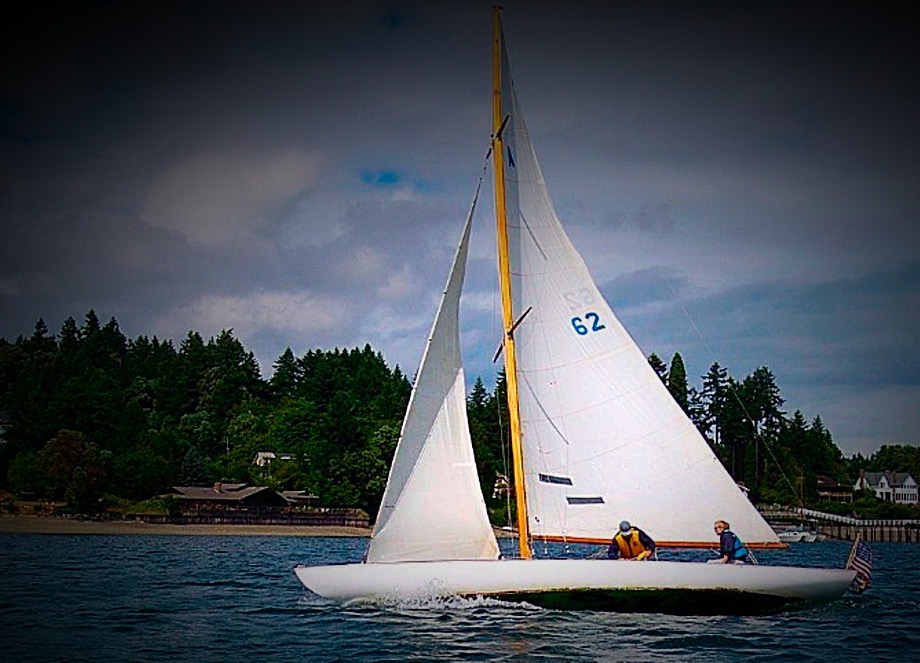
Sail Number: A
Vessel Type: Fractional Sloop
LOA: 30′ 6″ / 9.29m – LOD: 30′ 6″ / 9.29m – LWL: 21′ 6″ / 6.55m – Beam: 6′ 6″ / 1.98m – Draft: 4’9″ / 1.45m – Displacement: 4,559 lbs / 2067.92kg Ballast: 2,835 lbs. / 1285.93kg – Sail Area: 377 sq ft – Design Number: – Yard Number: – Rig: Fractional Sloop – Designer: W. Starling Burgess – Built by: Abeking & Rasmussin, Lemwerder, Germany – Original Owner: – Year Built: 1929 – Website: The Atlantic Class
Historical:
The Atlantic Class – In the summer of 1928, W. Starling Burgess, who would later design Ranger and two other J Boats that defended the America’s Cup, sailed from yacht club to yacht club on Long Island Sound in a 30-foot prototype sloop he called the Atlantic Coast One Design. Burgess’ creation was intended to promote a class of fast boats that were identical for racing and could be daysailed as well. Eighty orders for the boat were taken that first summer, and the wooden hulls were built in production-line style at the German shipbuilding firm of Abeking and Rasmussen.
In March, 1929, the new owners gathered excitedly at New York’s Harvard Club to formalize a class association. They voted to change the name of the boat from “Atlantic Coast One Design” to, simply, “Atlantic”. Pequot YC in Southport, CT, whose members had purchased the first 20 Atlantics, offered to hold the first national championship that summer, and there was even a report that Cuba was planning to order four boats and hold a midwinter championship the next year. The class was off!
The new boats, shipped to the United States on the decks of freighters, had been very well built, and the first summer of racing was a success. Remarked Everett B. Morris, the noted columnist of the New York Herald Tribune, “Theoretically, the Atlantics are planked with mahogany on oak ribs, but the more active these boats become, the stronger grows the belief that they are constructed of rubber.” Twenty more boats were ordered that fall, and the Class’s first generation was built to its goal of 100 boats by the summer of 1930.
Atlantic racing flourished during the Thirties and Forties with the participation of such distinguished sailors as Bob Bavier, Clifford Mallory, David Noyes, Bus and Bob Mosbacher, Corny Shields, George Hinman and Briggs Cunningham. But by the early Fifties, the boats were beginning to show their age. Fifteen of the original hundred had been lost in storms, and many of the rest required a good deal of bailing while racing. Something had to be done.
At the 25th annual Atlantic meeting in the fall of 1953, 12-Meter skipper Cunningham offered to put up $5,000 to help the class build a mold and a demonstration fiberglass boat. The Cape Cod Shipbuilding Company used Rumour, No. 27, to make a plug and attached the original keel, rudder, spars and hardware to a new fiberglass hull. Author John Hersey bought the revamped Rumour and raced her during the 1954 season to see how she compared with the wooden boats. The class wanted to be sure that the older boats would remain competitive. Hersey later wrote, “With her hull so close to the original design, the glass boat sails well in all weather…she takes chop in a seaway particularly well, without pounding, seeming to put a shoulder in and push through.” The second generation of Atlantics was born, and the class became one of the first to convert to glass.
During all this time, no new Atlantics were built. The rumor mill had it that the design plans were destroyed when Abeking and Rasmussen was bombed during World War II.
It wasn’t until 1962 that a boat with a sail number greater than 100 finally appeared. No. 101 was the first of a third generation of Atlantics that came out of a new mold that included the keel. Nearly 50 new boats have been built in the years since then, and the class has adopted a number of modifications to keep the boat modern and competitive. A new spinnaker design, with higher shoulders and greater area, appeared in 1965; aluminum spars were permitted in 1969; the jib became a deck-sweeper in 1973; in 1984 adjustable backstays were allowed. Each change has been made with careful attention to the strict one-design principles that have characterized the class since its inception.
Provenance (The Wall of Remembrance – The Owners, Crew & Notable Guest):
Owner:
